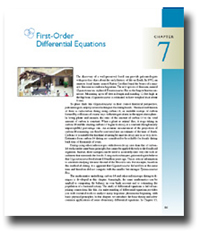 <a onClick="window.open('/olcweb/cgi/pluginpop.cgi?it=jpg::::/sites/dl/free/0219532320/295036/ch07.jpg','popWin', 'width=NaN,height=NaN,resizable,scrollbars');" href="#"><img valign="absmiddle" height="16" width="16" border="0" src="/olcweb/styles/shared/linkicons/image.gif"> (22.0K)</a> <a onClick="window.open('/olcweb/cgi/pluginpop.cgi?it=jpg::::/sites/dl/free/0219532320/295036/ch07.jpg','popWin', 'width=NaN,height=NaN,resizable,scrollbars');" href="#"><img valign="absmiddle" height="16" width="16" border="0" src="/olcweb/styles/shared/linkicons/image.gif"> (22.0K)</a> |
The discovery of a well-preserved fossil can provide paleontologists with priceless clues about the early history of life on Earth. In 1993, an amateur fossil hunter named Ruben Carolini found the bones of a massive dinosaur in southern Argentina. The newspecies of dinosaur, named Giganotosaurus, replaced Tyrannosaurus Rex as the largest known carnivore. Measuring up to 45 feet in length and standing 12 feet high at the hip bone, Giganotosaurus is estimated to have weighed in at about 8 tons.
To place finds like Giganotosaurus in their correct historical perspective, paleontologists employ several techniques for dating fossils. The most well known of these is radiocarbon dating using carbon-14, an unstable isotope of carbon formed by collisions of cosmic rays with nitrogen atoms in the upper atmosphere. In living plants and animals, the ratio of the amount of carbon-14 to the total amount of carbon is constant. When a plant or animal dies, it stops taking in carbon-14 and the existing carbon-14 begins to decay, at a constant (though nearly imperceptible) percentage rate. An accurate measurement of the proportion of carbon-14 remaining can then be converted into an estimate of the time of death. Carbon-14 is suitable for this kind of dating because its decay rate is so very slow. Estimates from carbon-14 dating are considered to be reliable for fossils dating back tens of thousands of years.
Dating using other radioisotopes with slower decay rates than that of carbon- 14works on the same basic principle, but cannot be applied directly to the fossilized organism. Instead, these isotopes can be used to accurately date very old rock or sediment that surrounds the fossils. Using such techniques, paleontologists believe that Giganotosaurus lived about 100 million years ago. This is critical information to scientists studying life near the end of the Mesozoic era. For example, based on this method of dating, it is apparent that Giganotosaurus did not live at the same time and therefore did not compete with the smaller but stronger TyrannosaurusRex.
The mathematics underlying carbon-14 and other radioisotope dating techniques is developed in this chapter. Amazingly, the same mathematics can be applied to computing the balance in your bank account and to estimating the population of a bacterial colony. The study of differential equations is full of surprising connections like this. An understanding of differential equations provides you with essential tools to analyze many important phenomena beginning with basic physical principles. In this chapter, we introduce the basic theory and a few common applications of some elementary differential equations. In Chapter 15, we return to the topic of differential equations and present additional examples. However, a more thorough examination of this vast field will need to wait for a course focused on this topic. |





